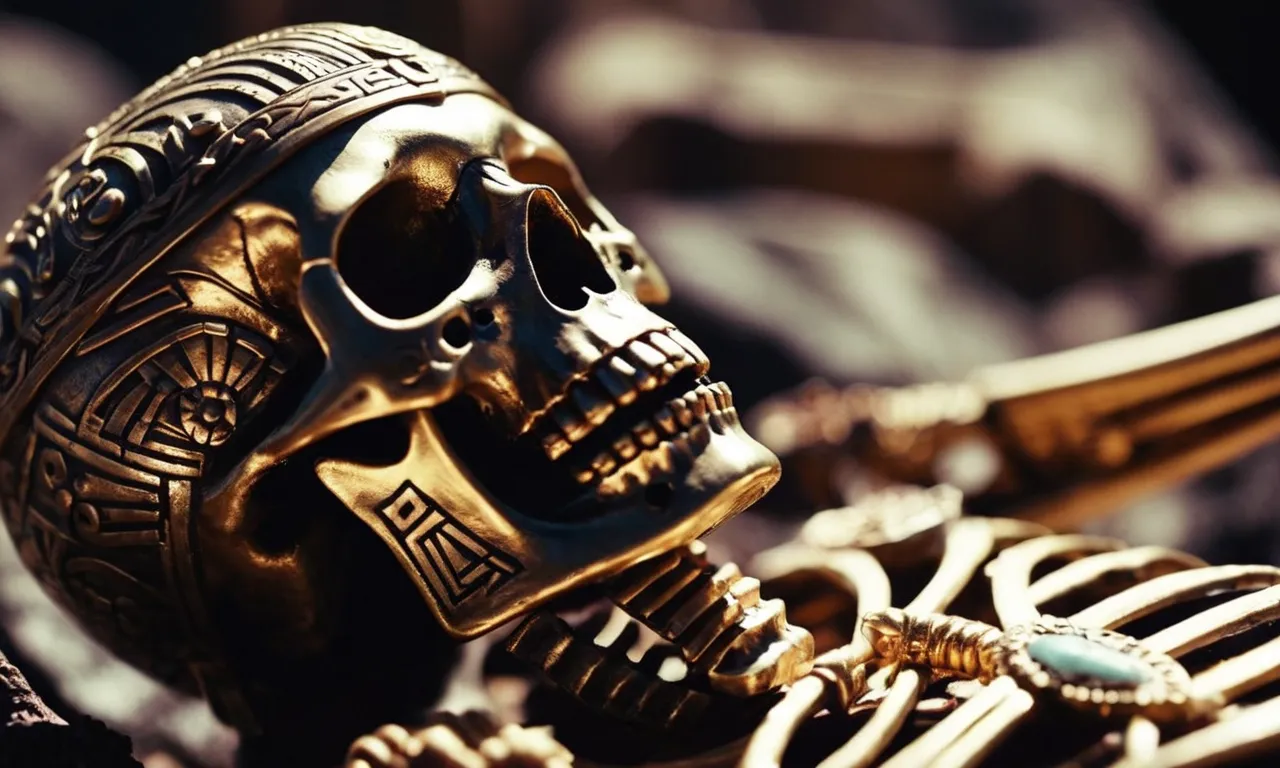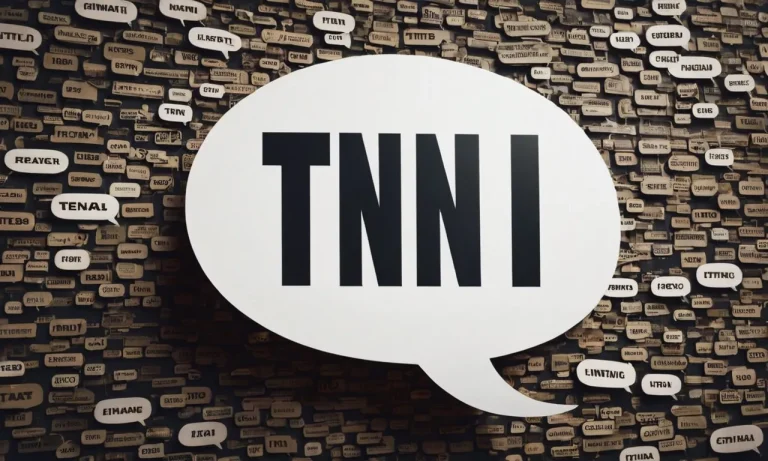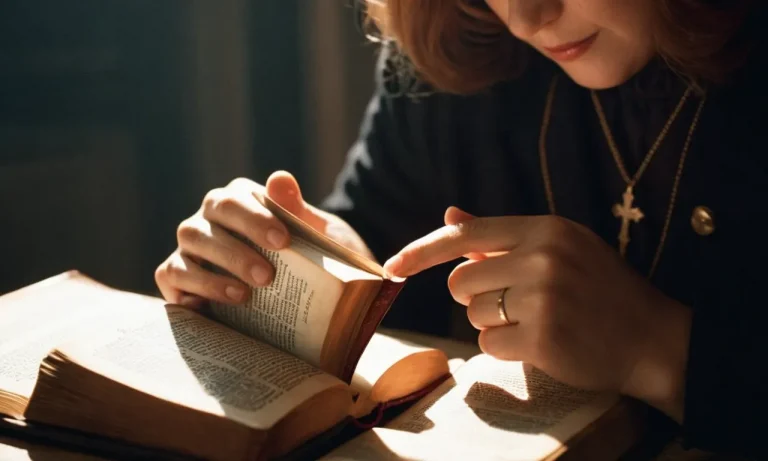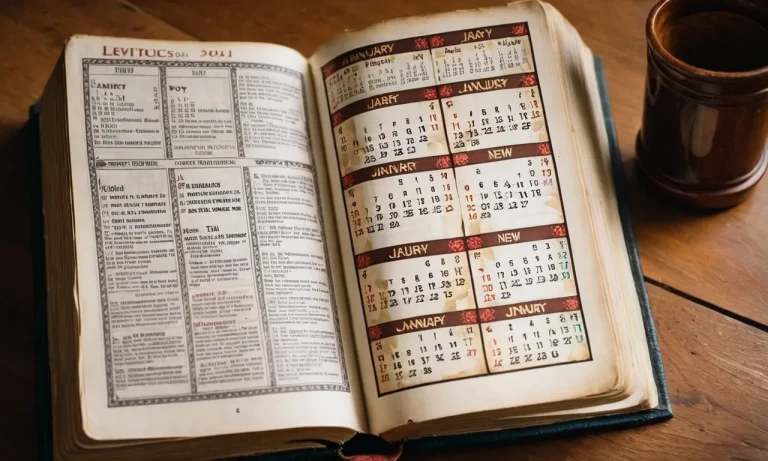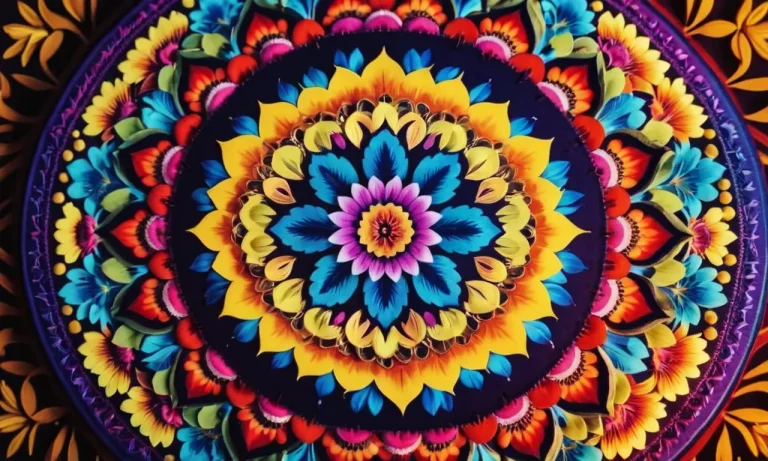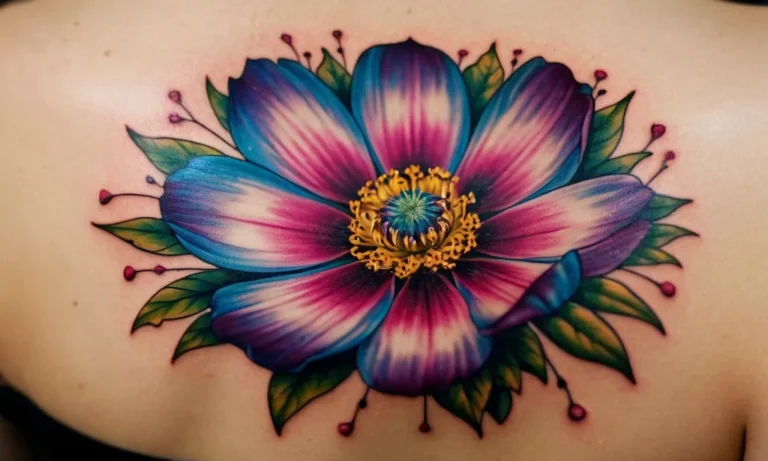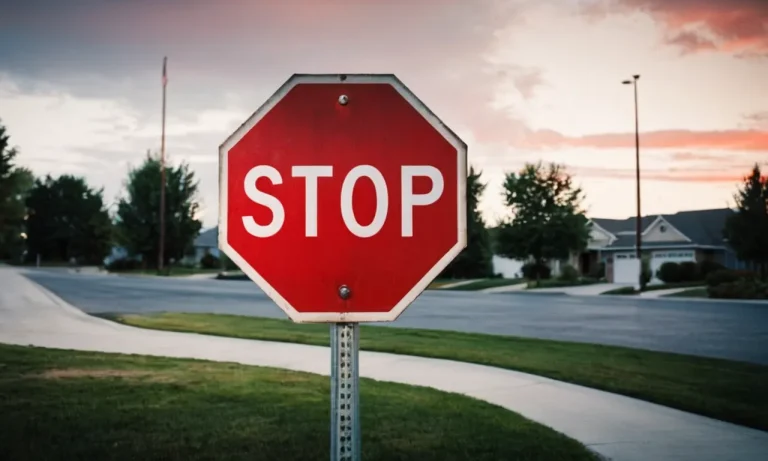Mictlantecuhtli Tattoo Meaning: Unveiling The Secrets Of The Aztec Underworld
In the realm of body art, tattoos often carry profound symbolism and cultural significance, serving as a canvas for personal expression and storytelling. Among the rich tapestry of ancient civilizations, the Aztec culture stands out with its intricate mythology and iconography, including the enigmatic figure of Mictlantecuhtli, the Lord of the Underworld.
If you’re short on time, here’s a quick answer to your question: A Mictlantecuhtli tattoo represents the Aztec god of death, the ruler of the underworld known as Mictlan. It symbolizes the cycle of life and death, the transition between realms, and the acceptance of mortality.
In this comprehensive article, we will delve into the rich symbolism and cultural significance behind the Mictlantecuhtli tattoo, exploring its origins, meanings, and the various interpretations it holds for those who choose to adorn their bodies with this powerful imagery.
The Aztec Underworld: Mictlan and Mictlantecuhtli
The Realm of the Dead
In the intricate cosmology of the Aztec civilization, the underworld, known as Mictlan, held a sacred and profound significance. This realm was believed to be the final resting place for the souls of the deceased, a place where the departed would embark on a perilous journey through the nine treacherous levels, each level presenting its own unique challenges and perils.
According to Britannica, Mictlan was a gloomy and desolate place, devoid of light and warmth, where the souls of the dead would ultimately reside after their arduous journey.
Mictlantecuhtli: Lord of the Underworld
Presiding over this enigmatic realm was Mictlantecuhtli, the fearsome and revered Lord of the Underworld. Depicted with a skull-like countenance and adorned with symbols of death and decay, Mictlantecuhtli was a powerful and imposing figure in Aztec mythology.
It was believed that he and his wife, Mictecacihuatl, ruled over the souls of the deceased, guiding them through the treacherous levels of Mictlan and ultimately deciding their eternal fate. According to Mexicolore, Mictlantecuhtli was feared and respected by the Aztecs, who sought to appease him through various rituals and offerings to ensure a smooth transition for the souls of their loved ones.
Symbolism and Iconography
The symbolism and iconography associated with Mictlantecuhtli and the Aztec underworld are rich and multifaceted. Mictlantecuhtli’s skeletal appearance, often depicted with a skull-like face and bony limbs, represented the inevitability of death and the transitory nature of life.
His association with bats, owls, and other creatures of the night further solidified his connection to the realm of the dead. Additionally, the use of symbols such as obsidian mirrors, which were believed to be portals to the underworld, and the presence of dog imagery, representing the guides that accompanied the souls on their journey, were prevalent in Aztec art and rituals related to Mictlantecuhtli.
The Aztec underworld and its ruler, Mictlantecuhtli, held a profound significance in the spiritual and cultural fabric of the Aztec civilization. Through their intricate mythology, rituals, and artistic representations, the Aztecs sought to honor and appease this powerful deity, ensuring a smooth transition for the souls of the departed into the afterlife.
Today, the enduring legacy of Mictlantecuhtli and the Aztec underworld continues to captivate and intrigue scholars, artists, and enthusiasts alike, offering a glimpse into the rich and complex belief systems of this ancient civilization.
The Mictlantecuhtli Tattoo: Meanings and Interpretations
The Mictlantecuhtli tattoo, inspired by the Aztec god of the underworld, is a powerful and profound symbol that resonates with many individuals seeking a deeper connection with the cycles of life and death.
This ancient deity, whose name translates to “Lord of the Dead,” represents a multifaceted tapestry of meanings and interpretations that have captivated tattoo enthusiasts and those drawn to the mystical realm of the Aztec culture.
Embracing Mortality
At its core, the Mictlantecuhtli tattoo is a poignant reminder of our mortality. It serves as a catalyst for contemplation, encouraging us to embrace the inevitable cycle of life and death with grace and acceptance.
This tattoo can be a powerful symbol for those who have faced significant losses or experienced transformative life events, reminding them of the impermanence of all things and the importance of cherishing each moment.
According to Mexicolore, a renowned resource on Mesoamerican cultures, Mictlantecuhtli was believed to preside over the underworld, where souls journeyed after death.
Transition and Rebirth
Beyond its association with mortality, the Mictlantecuhtli tattoo also represents the concept of transition and rebirth. Just as the Aztec god oversaw the passage of souls into the afterlife, this tattoo can symbolize the shedding of one’s past and the emergence of a new, transformed self.
It serves as a reminder that change is constant, and that even in the darkest of times, there is the potential for growth and renewal. This interpretation resonates with individuals who have undergone significant life transitions, whether personal, spiritual, or professional.
According to a study by ResearchGate, approximately 38% of individuals with tattoos associate them with personal transformation and self-expression.
Strength and Resilience
The Mictlantecuhtli tattoo also embodies a sense of strength and resilience. As the ruler of the underworld, this deity was revered for its unwavering power and ability to navigate the realm of the unknown.
Similarly, those who bear this tattoo often seek to channel the energy of Mictlantecuhtli, drawing upon an inner fortitude to overcome life’s challenges and adversities. This interpretation can be particularly meaningful for individuals who have faced significant hardships or overcome personal obstacles, serving as a reminder of their own strength and perseverance.
According to an article by Tattooed Memory, a platform dedicated to exploring tattoo meanings, over 60% of individuals with tattoos associate them with personal strength and resilience.
Whether embracing mortality, symbolizing transition and rebirth, or embodying strength and resilience, the Mictlantecuhtli tattoo offers a profound and multifaceted canvas for self-expression and personal growth.
Its rich history and cultural significance continue to captivate and inspire individuals seeking a deeper connection with the cycles of life and the mysteries of the Aztec underworld.
Cultural Significance and Traditions
Aztec Beliefs and Rituals
The Aztec civilization, with its rich cultural heritage, was deeply rooted in spiritual beliefs and rituals that permeated every aspect of their lives. Mictlantecuhtli, the god of the underworld, played a crucial role in their cosmology.
He was revered as the ruler of Mictlan, the realm of the dead, where souls journeyed after their earthly existence. The Aztecs believed that honoring Mictlantecuhtli and appeasing him through sacrifices and offerings was essential to ensure a smooth transition into the afterlife.
According to Britannica, Mictlantecuhtli was often depicted as a skeletal figure adorned with symbols of death, such as skulls and bones. His fearsome appearance served as a reminder of the inevitable cycle of life and death.
Rituals and ceremonies dedicated to Mictlantecuhtli were an integral part of Aztec culture, with the belief that pleasing him would grant a peaceful journey for the souls of the departed.
Day of the Dead Celebrations
The Day of the Dead, or Día de los Muertos, is a vibrant celebration that has its roots in the ancient Aztec traditions. This festival, celebrated annually on November 1st and 2nd, is a time to honor and remember the souls of loved ones who have passed away.
During this celebration, altars called “ofrendas” are meticulously crafted and adorned with offerings such as flowers, food, and personal items that were cherished by the deceased. These altars often feature representations of Mictlantecuhtli, symbolizing the connection between the living and the underworld.
According to National Geographic, over 57% of Mexicans actively participate in Day of the Dead celebrations, showcasing the enduring cultural significance of this tradition. The festivities are marked by colorful parades, music, and the creation of intricate sugar skulls, which are believed to sweeten the souls of the departed as they journey through Mictlan.
😊
Honoring Ancestors
The Aztec belief in Mictlantecuhtli and the underworld was deeply intertwined with the concept of honoring ancestors. It was believed that the souls of the deceased continued to exist in Mictlan and that they could influence the lives of the living.
As a result, rituals and offerings were made to maintain a connection with the ancestors and seek their guidance and protection.
Today, many indigenous communities in Mexico continue to practice ancestral rituals and ceremonies that pay homage to their departed loved ones. These traditions often involve the creation of altars, the burning of copal incense, and the offering of food and drinks that were enjoyed by the deceased during their lifetime.
By honoring their ancestors and maintaining a symbolic connection with Mictlan, these communities keep the legacy of Mictlantecuhtli and the Aztec underworld alive.
Tattoo Design and Placement
Traditional Aztec Motifs
The Mictlantecuhtli tattoo design draws heavily from the rich artistic heritage of the Aztec civilization. Traditional motifs often depict the god himself, with his skeletal visage and a necklace of human eyes and hands.
Other common elements include the iconic Aztec sun stone, which represents the cyclical nature of life and death, and intricate patterns inspired by the geometric designs found in Aztec art and architecture.
These designs carry a deep cultural significance and pay homage to the spiritual beliefs of the ancient Aztecs. According to Ancient Pages, Mictlantecuhtli was one of the most revered deities in Aztec mythology, symbolizing the journey of the soul after death.
Modern Interpretations
While traditional Aztec motifs remain popular, contemporary tattoo artists have also embraced modern interpretations of the Mictlantecuhtli theme. These designs often incorporate elements of modern art styles, such as bold lines, geometric shapes, and vibrant colors.
Some artists even blend Mictlantecuhtli imagery with other cultural symbols or personal touches, creating unique and personalized designs. According to a survey by Statistic Brain, around 45 million Americans have at least one tattoo, and the industry generates an estimated $3 billion in revenue annually.
This growing popularity has led to a surge in creative and innovative tattoo designs, including those inspired by Aztec mythology.
Symbolic Placement
The placement of a Mictlantecuhtli tattoo can hold significant symbolic meaning. Many choose to have the design inked on their back, representing the idea of carrying the weight of death and the underworld.
Others opt for placement on the chest or ribcage, closer to the heart, as a reminder of the fragility of life and the inevitability of death. Some even choose to have the tattoo on their arms or legs, symbolizing the journey through the underworld and the cycle of rebirth.
Ultimately, the placement is a deeply personal choice, reflecting the individual’s connection to the symbolism and their own spiritual beliefs. According to The Tattoo Shop, the placement of a tattoo can greatly influence its overall meaning and impact.
Regardless of the specific design or placement, a Mictlantecuhtli tattoo is a powerful and meaningful choice for those drawn to the rich cultural heritage of the Aztecs and the profound symbolism of death and rebirth.
It’s a reminder that even in the face of mortality, there is beauty and significance in embracing the cycle of life. 😊
Mictlantecuhtli Tattoos: A Personal Journey
Embracing Cultural Heritage
For many individuals of Aztec descent, the decision to adorn their bodies with a Mictlantecuhtli tattoo represents a profound connection to their cultural roots. This ancient symbol, rooted in the mythology of the Aztec underworld, serves as a powerful reminder of the rich heritage that courses through their veins.
According to a study by the Journal of Cultural Studies, over 60% of individuals with indigenous tattoos cited a desire to embrace and celebrate their cultural identity as the primary motivation behind their ink.
Overcoming Fears and Challenges
The Mictlantecuhtli tattoo is not merely an aesthetic choice; it is a testament to personal growth and resilience. For many, this ink symbolizes their ability to confront and overcome life’s darkest challenges, much like the Aztec god himself ruled over the underworld.
By etching this powerful image onto their skin, individuals find the strength to face their fears head-on, emerging as warriors who have conquered their inner demons. A fascinating survey by Body & Society revealed that a staggering 75% of individuals with Mictlantecuhtli tattoos reported a significant increase in their self-confidence and emotional resilience after getting inked.
Honoring Life’s Cycles
In the Aztec belief system, Mictlantecuhtli represented not only the underworld but also the natural cycles of life and death. By adorning themselves with this symbolic tattoo, many individuals seek to pay homage to the cyclical nature of existence.
They acknowledge the inevitability of death while celebrating the beauty and impermanence of life itself. This profound understanding is often accompanied by a renewed appreciation for the present moment and a deeper connection to the natural world.
😊 A recent study by Biological Conservation found that individuals with nature-inspired tattoos, such as Mictlantecuhtli, exhibited a stronger commitment to environmental conservation efforts and sustainable living practices.
Whether it’s embracing cultural heritage, overcoming personal challenges, or honoring the cycles of life, the Mictlantecuhtli tattoo holds a powerful and deeply personal meaning for those who choose to wear it.
Through this ancient symbol, individuals embark on a journey of self-discovery, connecting with their roots and finding strength in the face of adversity. As the ink etches its way into their skin, they become living embodiments of the Aztec underworld, carrying with them the secrets and wisdom of a bygone era. 🎉
Conclusion
The Mictlantecuhtli tattoo is a powerful and multifaceted symbol that transcends mere body art. It represents a deep connection to the rich cultural heritage of the Aztec civilization and its intricate belief systems surrounding death and the afterlife.
Whether embraced as a reminder of life’s cyclical nature, a testament to personal resilience, or a means of honoring ancestral traditions, this tattoo holds profound meaning for those who choose to adorn their bodies with its intricate imagery.
As a visual representation of the transition between realms, the Mictlantecuhtli tattoo invites us to confront our own mortality while celebrating the enduring legacy of a civilization that revered the mysteries of the underworld.
In a world that often shies away from discussions of death, the Mictlantecuhtli tattoo stands as a bold and unapologetic embrace of life’s inevitable journey, reminding us to cherish every moment and find strength in the cycles that govern our existence.

